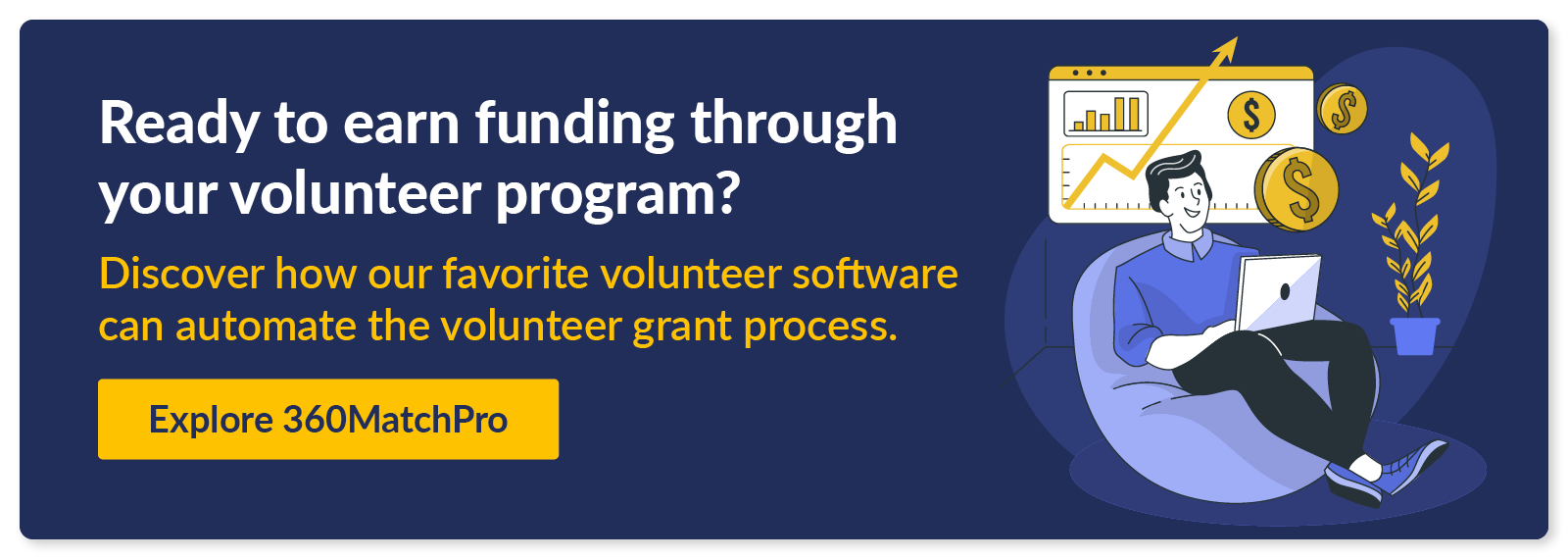3 Types of Volunteer Software and Tools Nonprofits Need
Approximately one-third of the nonprofit workforce is volunteers, and these supporters keep your nonprofit running by completing program-related tasks, assisting with fundraisers, spreading awareness, and generally lending their time and energy to support your organization. However, managing a team that can come and go randomly is a challenge, and to compensate, many nonprofits turn to volunteer software solutions.
Nonprofits can benefit from several types of volunteer software. In this guide, we’ll explore three kinds of nonprofit software focused on volunteers and how your organization can make the most of each platform. Specifically, we’ll cover:
- Volunteer Software FAQ
- Volunteer Management Software
- Volunteer Grant Database
- Peer-to-Peer Software
- Volunteer Software Tips
First, let’s address the fundamentals of volunteer software. If this is your first time investing in this type of solution, you’ll have a baseline of what to prioritize.
Volunteer Software FAQ
What is volunteer software?
Volunteer software includes technology platforms designed for nonprofits to manage, engage, and interact with their volunteers. This includes tools that allow nonprofits to message volunteers, create shift schedules, and post volunteer opportunities. It also includes platforms that allow volunteers to complete specific tasks, such as fundraising on a nonprofit’s behalf.
Be aware that various volunteer software solutions include different features. For example, even if two vendors both offer volunteer management software, one might have features for recruitment and training, whereas another focuses specifically on communication and organization.
Why do nonprofits need volunteer software?
Small nonprofits can run volunteer programs without software supporting their efforts. However, as your volunteer program grows, so will its level of complexity. With more volunteers, programs, and tasks, nonprofits can benefit greatly from using a centralized system to stay organized.
With the help of volunteer software, nonprofits can:
- Better manage resources. Volunteer software collects and monitors data related to your volunteer program. This allows you to understand what resources you have at your disposal, how they are being used, and if they could be better allocated. For example, you might notice certain programs are at capacity for volunteers while others need more support. In this case, you can edit your schedule to fix this discrepancy.
- Improve volunteer retention. By running an organized volunteer program where supporters receive prompt communication and clear direction, you’re more likely to have returning volunteers.
- Launch specialized programs. Certain types of volunteer initiatives require software to function. For example, if you plan to offer virtual volunteering opportunities, you’ll likely need software to connect with these supporters and assign tasks.
Volunteer software platforms vary in scale, and different nonprofits will need different levels of support. While a smaller nonprofit might be content using its CRM’s volunteer engagement features, a larger organization may prefer a highly customizable volunteer-specific management platform.
Is volunteer software free?
Volunteer software is available at a variety of price points. Some solutions may offer free packages with limited features, but most platforms operate on a monthly or annual subscription system.
For example, volunteer software vendor POINT has three price points, including a free option that provides core management features, such as time tracking and calendar management.
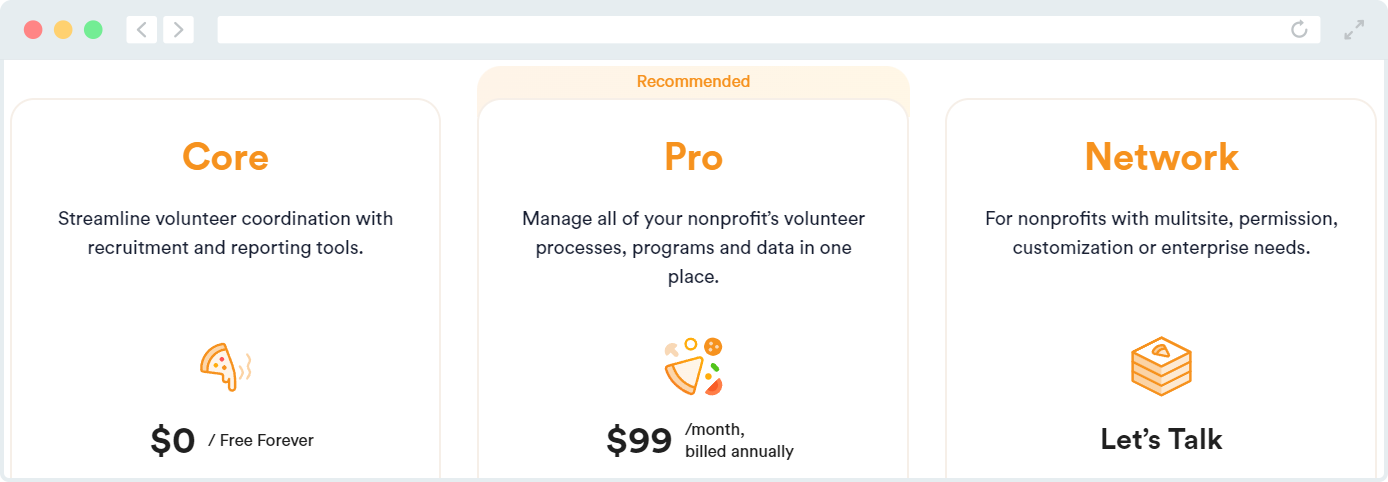
However, other desirable features, like background checks and waivers, require upgrading to a paid plan. Additionally, POINT, like many other volunteer software providers, offers custom pricing solutions for enterprise-sized nonprofits.
Volunteer Management Software
Volunteer management software is the most common type of volunteer software. These platforms help nonprofits organize and run nearly every part of their volunteer program, making them essential for any growing nonprofit.
Various volunteer management software platforms specialize in different aspects of volunteer management. However, every platform should offer these core features:
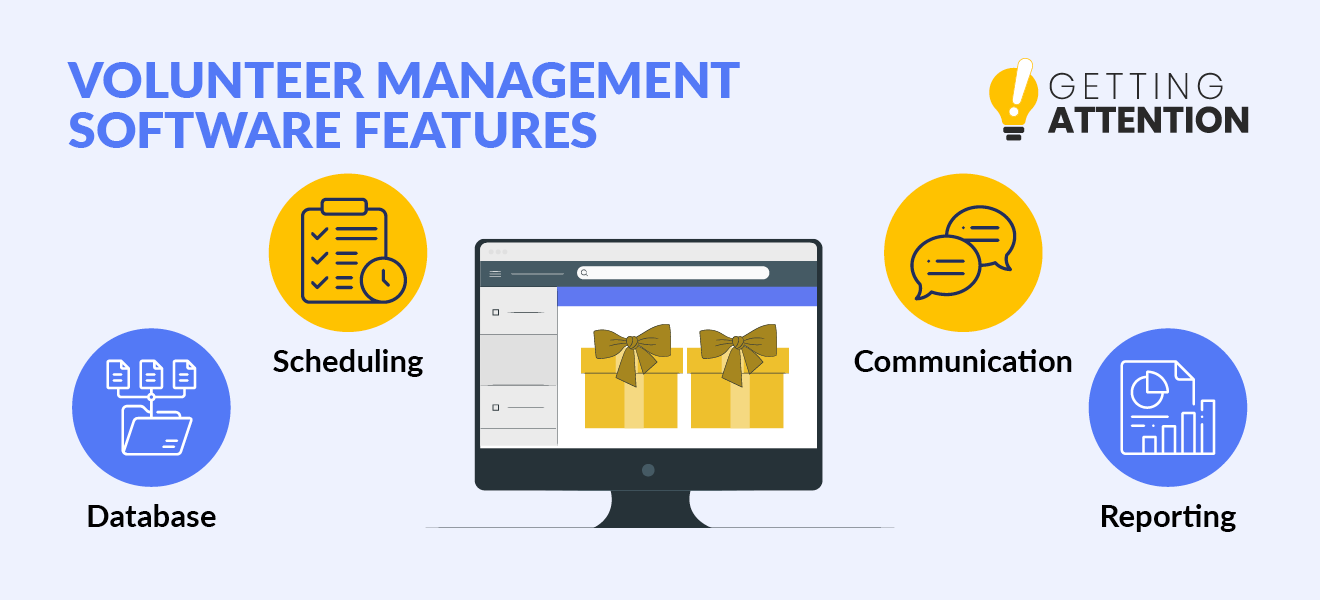
- Database. Many nonprofits use CRMs, which house donor data, such as their engagement history, contact details, and payment information. Some CRMs also provide profile management features for non-donors, such as volunteers, but dedicated volunteer management platforms are likely to provide more robust offerings. Look for platforms that allow you to easily build volunteer profiles, search your database for specific individuals, and store your supporters’ information securely.
- Scheduling. Planning and managing volunteer shifts is essential for maintaining a functional volunteer program. Assess management platforms based on their scheduling-related features, such as calendar creation, shift assigning and claiming processes, and bulk scheduling.
- Communication. To keep your volunteer program running smoothly, volunteer managers will need to coordinate with numerous supporters to provide direction, ensure shifts are filled, and answer questions. Your volunteer software should aid this process with communication tools, such as the ability to contact volunteers via multiple channels (like email, text messaging, and volunteer app notifications) and automatic messaging (like upcoming shift reminders).
- Reporting. Reporting tools help you make sense of your data to determine where your volunteer program is succeeding and what could be improved. For instance, all volunteer management software should have basic hours tracking tools. You might use this information to determine which times of year your nonprofit has the highest volunteer capacity.
When assessing volunteer management software, consider your nonprofit’s needs. Some organizations might be looking for an out-of-the-box solution with an app volunteers can engage with, whereas others might want a customizable platform and sophisticated reporting features. Every vendor has its own specialties and strengths, so take note of what features they highlight and ask questions during demos and sales pitches about specific use cases.
Bonus: What are corporate volunteer management solutions?
While for-profit businesses don’t have volunteers, some corporations do have software with volunteer management features. Specifically, businesses with corporate social responsibility (CSR) programs often use software to manage these initiatives.
CSR programs include grantmaking, sponsorships, in-kind donations, and employee volunteer initiatives. Some examples of corporate volunteer programs are:
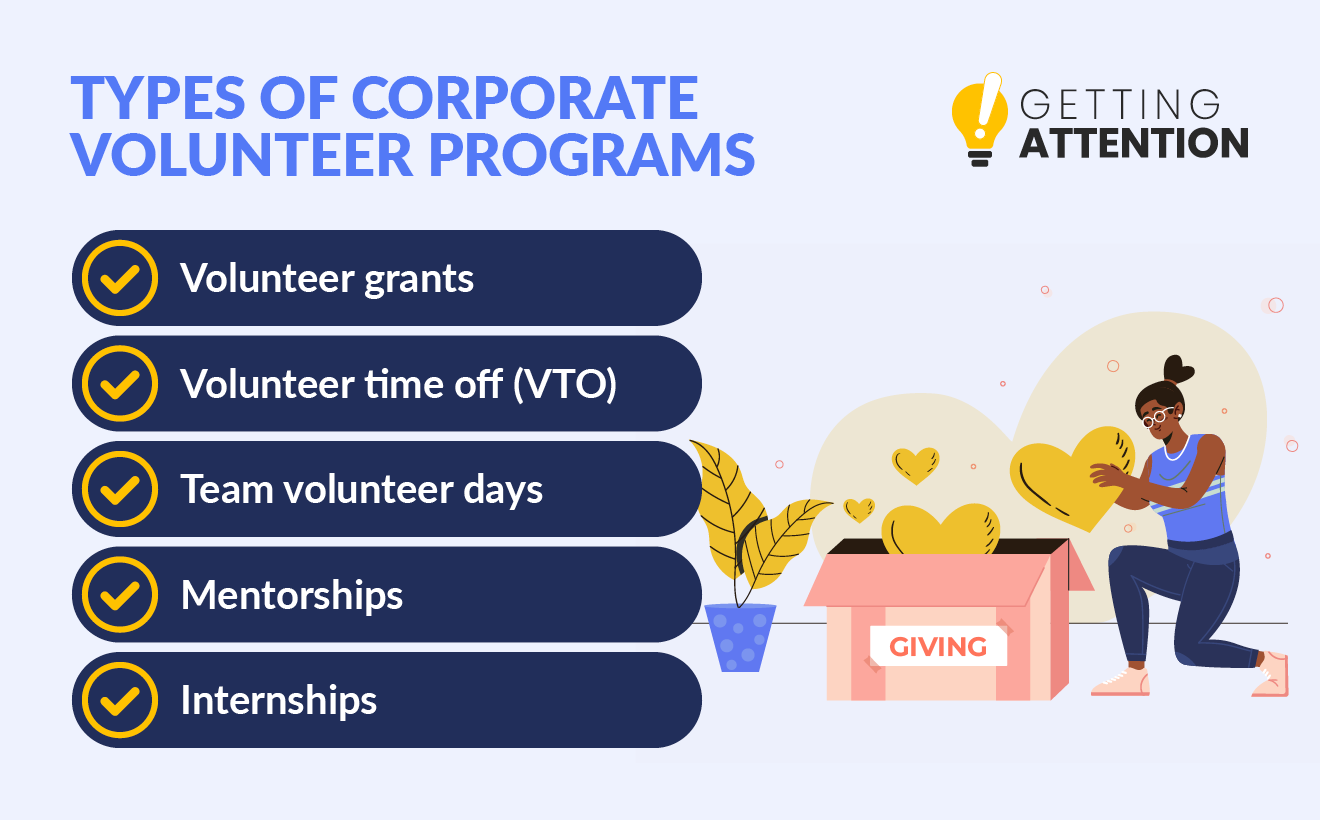
- Volunteer grants
- Volunteer time off (VTO)
- Team volunteer days
- Mentorships
- Internships
To encourage employee volunteering and track volunteer initiatives’ results, businesses use CSR software. These tools allow employees to report their volunteer hours, submit volunteer grant applications, and request VTO. With some platforms, employees can search for volunteer opportunities.
Some CSR vendors provide users with a database of reputable nonprofits. These platforms then allow users to search for relevant volunteer openings or even let leadership highlight and promote specific volunteer opportunities to employees. Explore top CSR vendors to see if it’s possible to submit your nonprofit for consideration to get featured in these databases.
Volunteer Grant Database
While volunteer management software allows your volunteer program to function, tools like volunteer grant databases enable nonprofits to earn additional value from their programs.
A volunteer grant database provides nonprofits and volunteers with information about corporate giving and CSR programs related to volunteering. These databases allow volunteers to search for their employers and discover the following details:
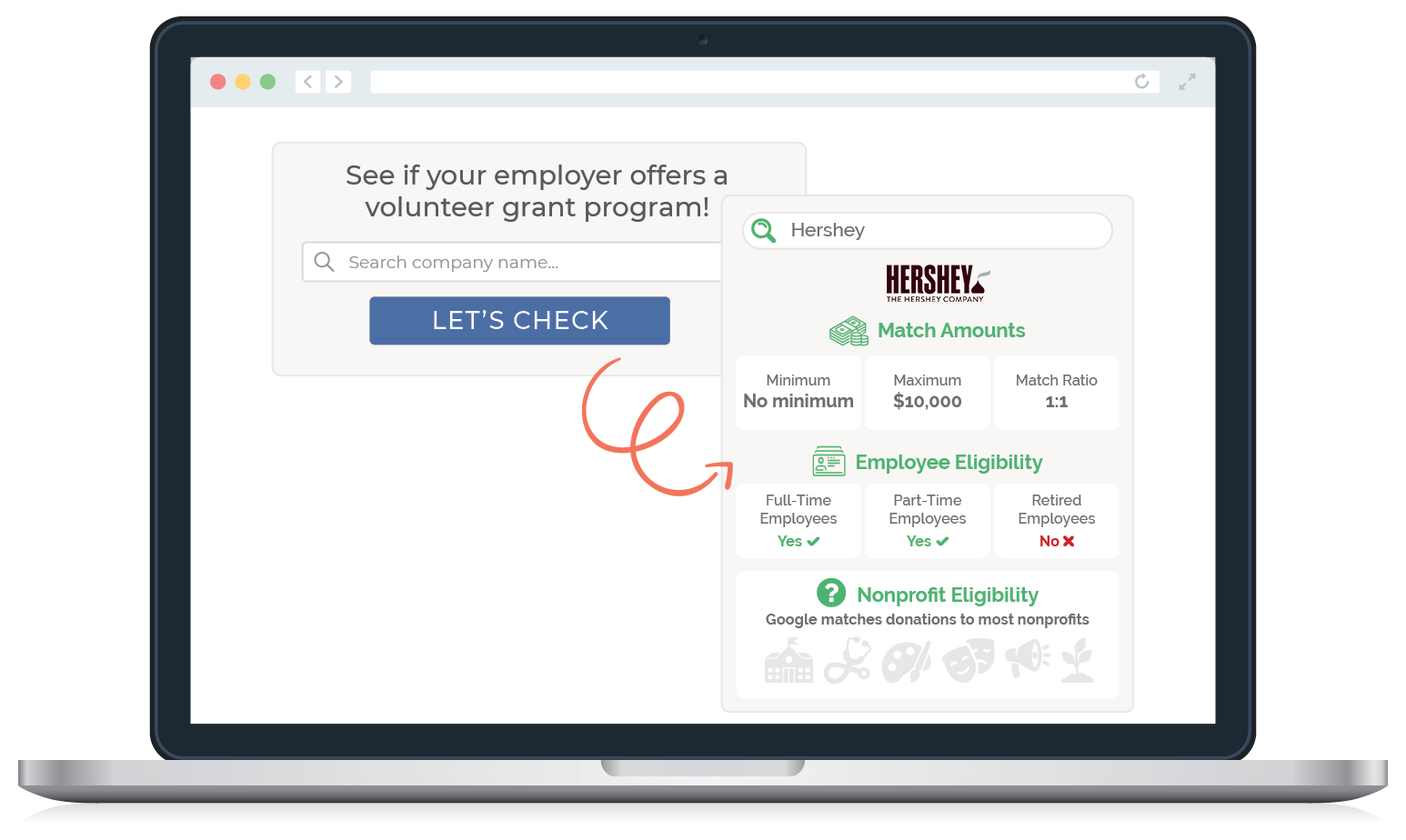
- Their program eligibility. If an employer offers volunteer grants or VTO, a volunteer grant database will provide relevant information about the program. This includes which employees are eligible. For instance, a company might provide volunteer grants to all employees, but only full-time staff are eligible for VTO.
- Program requirements. Every company has its own volunteer grant requirements, making it challenging for nonprofits to provide guidance to volunteers. A volunteer grant database can help supporters find relevant information, such as how many hours they need to volunteer, what types of nonprofits are eligible, and when they need to submit their volunteer grant application.
- Next steps. Discovering if a supporter is eligible for a volunteer grant or VTO is great. But what do they do next? Look for a volunteer grant database that provides links to relevant forms and pages supporters can follow to take the next steps to apply immediately after confirming their eligibility.
Volunteer grants and VTO earn your nonprofit additional revenue and additional volunteers. Many eligible supporters are unaware these initiatives exist, let alone if they qualify. By bringing them to your supporters’ attention, your volunteer program will become even more valuable.
Bonus: Our recommended volunteer grant database provider!
Currently, the top volunteer grant database on the market is Double the Donation Volunteering. Double the Donation originally specialized in matching gift software, but the volunteer functionality expands its offerings to provide users with information on overlooked volunteer grants and VTO opportunities.
A few of Double the Donation’s top features include:
- Comprehensive database. Double the Donation’s matching gift database covers 99.68% of all match-eligible donors. This same comprehensiveness applies to the volunteer arm of the database, meaning all of your eligible supporters should be able to find their employers’ information easily.
- User-friendly search process. 360MatchPro’s search tool is easy to embed on any page of your website, including your volunteer registration form. Use it to capture your volunteers’ employer data so you can streamline the search process and identify if they qualify for volunteer grants or VTO.
- Extensive integrations. Chances are that you will use your volunteer grant database alongside your volunteer management software. 360MatchPro has over 100 integrations with various CRMs, volunteer management platforms, and donation tools, meaning chances are you’ll be able to add it to your current tech stack with ease.
Get started with Double the Donation Volunteering by scheduling a demo to discuss its potential benefits for your nonprofit.
Gain more volunteers and have more time to train and retain them by leveraging VTO. Discover how you can take advantage of VTO in Double the Donation’s complete guide.
Peer-to-Peer Software
Peer-to-peer campaigns are a unique type of volunteer initiative. While volunteers often help with various fundraisers, in a peer-to-peer campaign, volunteers essentially run their own fundraising campaigns on your behalf.
As a unique type of program, peer-to-peer campaigns require specialized software. A few specific features include:
- Campaign page creation. Peer-to-peer campaigns succeed because volunteers are able to create unique donation pages that share their personal stories. This allows their friends and family to give in support of their loved one rather than a nonprofit they might be unfamiliar with. Choose a peer-to-peer solution that lets your volunteers add their own photos, share their stories, and even upload videos.
- Social sharing options. Most modern peer-to-peer campaigns operate online and make heavy use of social media platforms like Facebook and Instagram. Your volunteers should be able to easily share their campaign pages and updates on social media to promote their fundraiser to friends, family, and followers.
- Data and analytics. Like any volunteer program, it’s useful to have a bird’s eye view of your volunteers’ activities. Use your platform’s data and analytics tools to track how each volunteer’s campaign is performing so you can step in to lend a hand, provide encouragement, or offer congratulations.
Peer-to-peer campaigns straddle the lines between being fundraisers and volunteer initiatives. As such, you’ll likely find software guides and campaign tips categorized under both volunteer and fundraising management.
Regardless, look for software that enables volunteers to share their unique message and fundraise on your behalf with confidence.
Bonus: Peer-to-peer volunteer management tips!
Peer-to-peer volunteers operate fairly independently by managing their own outreach after getting their campaign pages live. However, that doesn’t mean your volunteers should totally handle it alone. Improve your peer-to-peer campaigns by:
- Providing branded assets. While you should encourage peer-to-peer volunteers to design their own campaign pages and outreach content, doing so without guidance can lead to a hodgepodge of messages that don’t represent your brand well. Instead, share your nonprofit’s style guide with them, as well as a library of branded images and assets they can use, such as your logo and professionally taken photos of your programs.
- Using gamification tools. Engage your volunteers by turning fundraising into a game. Some peer-to-peer platforms have gamification tools that do things like award volunteers badges and points for hitting milestones, such as raising a certain amount. Some even feature leaderboards, letting your volunteers engage in friendly competition with one another.
- Checking in routinely. Make sure your volunteers know they’re not fundraising alone. Have your volunteer supervisor check in with them regularly to answer questions, troubleshoot problems, and provide encouragement. This will not only improve volunteers’ campaigns but also ensure volunteers feel supported by your nonprofit.
Like with any volunteer initiative, you should also thank your volunteers for their hard work. Many nonprofits end their peer-to-peer campaigns with an event as a final opportunity to fundraise and celebrate volunteers. Consider handing out awards to top-performing volunteers or thanking your peer-to-peer fundraisers as a whole in speeches throughout your event.
Volunteer Software Tips
After researching various types of volunteer software and vendors, you’ve hopefully found a platform you think is right for your nonprofit. However, the success of your volunteer software solution depends on how you use it.
To ensure your software powers your volunteer program successfully, be sure to consider:
- Implementation timeline. If you’re investing in a highly customizable volunteer platform or changing volunteer software, you’ll likely have a considerable implementation timeline. Make plans to migrate data, work with technology consultants, and train your staff to use your new platform.
- Onboarding. All volunteers should attend an onboarding session before working with your nonprofit. In this meeting, go over how to perform volunteer tasks, who volunteers should go to with questions, and what expectations for working with your nonprofit are. Additionally, if volunteers will use any software, give them a tutorial on how to operate it.
- Integrations. Choose a volunteer platform that integrates with the rest of your technology stack. Software like 360MatchPro that has many integrations will let data flow seamlessly from platform to platform. This means you can access data on your volunteers with ease and without worrying about data getting siloed into one system.
Request demos for your top volunteer software candidates. During these sessions, ask questions not just about the software but about how the vendor will support you. Look for vendors who provide fast technical support, training, and extensive resource libraries.
More Volunteer Resources
Volunteer software can elevate your nonprofit’s operations by streamlining volunteer recruitment, management, and revenue generation. Explore the variety of volunteer platforms available to find solutions that fit your nonprofit’s need.
For more volunteering and software resources, check out these guides:
- Nonprofit Advertising: The Essential Guide (With Examples!) Volunteers can be key members of your advertising team. Explore key tips to improve your marketing campaigns that you can share with volunteers.
- 13 Must-Have Technology Grants for Nonprofits This Year. Looking for help funding your technology? Check out these top grants for nonprofits.
- Volunteer Appreciation: The Ultimate Guide +20 Ideas. Appreciating your volunteers is the easiest way to increase retention. Discover creative ways to show your thanks.


